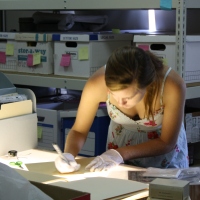by Emma Earnst
Today’s collection object is a little obscure, but it raises an important question in the ever-evolving discussion of preservation. This spring, the Chroma Projects Art Laboratory is hosting an open exhibition of work by local architects, musicians, and other artists with the topic of “The Future of Charlottesville” (btw, there is still time to apply if you are interested in submitting). Preservation Piedmont, a local group of which I am a part, will be partnering to host the event, in addition to submitting an entry of our own. As you might guess from our name, PresPied is dedicated to the preservation of local landscape and structures in the greater Charlottesville area. For this event, we really had to reach out of our “comfort zone” and consider not only the value of preservation for the future, but the realities of it. Of course we don’t assume that the world should have stopped in 1762, or 1865, or 1901, or even right now. Our world will ever be changing, and we will ever be creating a new history for ourselves as Charlottesvillians. Our purpose is to make sure that the elements of our past are not lost in that new life.
My personal view on topic is a complicated one, and perhaps more liberal than some. I see preservation the simplest way of staying green. And that may mean gutting a historic home for use as an office building, or preserving the integrity of building while adding an addition to make it suitable for modern living. Buildings and landscapes are personal places, and I just think they should be cared for and preserved, not simply discarded.
My fiancé would likely start arguing with me quite adamantly at this point, so I will get to the heart of our post today. A big discussion point is what to do with places with negative connotations. For example, growing up in Germany, I recall the exoduses of tourists to the existing concentration camps, of which there remained quite a few. These places are overwhelmingly negative and painful by nature, but I think most would agree: they absolutely should not be removed, because that pain serves as a reminder of what must NEVER happen again.
This is obviously an extreme example, though. What about a more local example- Comyn Hall, the house in downtown Charlottesville where Mayor J. Samuel McCue murdered his wife Fannie? On September 4, 1904, Mrs. McCue was bludgeoned, strangled, shot, and left in a filled bathtub on the second floor of 601 Park Street. Mayor McCue was convicted of the crime and hanged in the courtyard of the Charlottesville jail on January 20, 1905.
Sound like the kind of place you would want to live?
Well, in April 1929, just over a quarter century after the sensational McCue murder, trial, and conviction, the Charlottesville Home for the Aged converted and moved into the house. They changed the name of the house and their organization to “The Walker-Dickenson Home” at this time. In 1967, they changed it again to “Comyn Hall,” as it is still referred to today.* The retirement home also raised funds and built the addition to the side of the house in 1970.
Comyn Hall closed its doors in the late 2000s, and in May 2009, an estate sale was held of the remaining contents of the home. One of these contents was the bathtub from 1904- the very bathtub Fannie McCue had been found dead in. According to a Daily Progress correspondent, the tub was going to be donated to us here at the Historical Society. It never was, and quite frankly, I’m okay with that…
Comyn Hall has since been renovated as an apartment building, and is still accepting applications for rent.
What is your take on the preservation of places like these?
*The group apparently usurped the name Comyn Hall from a colonial mansion with that name, erected in 1846 John Cochran, who also owned the ground on which the newer Comyn Hall stands.


Reblogged this on Inspiredweightloss.